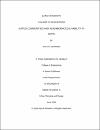Gated Communities and Neighborhood Livability in Doha
| Advisor | Petruccioli, Attilio |
| Advisor | Grichting, Anna |
| Author | Al Shawish, Ayla |
| Available date | 2016-12-11T09:20:31Z |
| Publication Date | 2016 |
| Abstract | Gated communities are a widespread phenomenon now found in many regions around the world. A gated community is mainly characterized by a focus on physical security measures such as gates, walls, guards, and closed circuit surveillance cameras. For the past 50 years, there has been growing criticism about their negative impact on the livability of neighborhoods. Nevertheless, this phenomenon remains popular in the emerging cities of the Arabian Gulf region that are adopting this residential development strategy in their urban growth patterns. More than 454 residential gated communities were located in Doha, the capital of the state of Qatar, as per the 2014 census (Qatar map, 2014), and their numbers are growing. Currently, there is a movement taking place in Qatar to restructure its urban planning principles in order to achieve a transformative move towards a more livable urban form. Therefore, the consistent emergence of such gated communities has become a stimulating piece of inquiry, as academics, engineers, and urban planners continue to question the suitability and potential impacts of gated communities as some of the most persistent and popular residential developments in Doha’s neighborhoods. This study investigates residential gated communities in Doha and their relation to a neighborhood’s livability, focusing on the Al Waab neighborhood as a case study. Site analysis, observation, morphological analysis, focus group interviews, and a questionnaire survey were adopted as suitable methodological tools for the investigation of the study area. The analysis is grounded in a perspective that recognizes the phenomenon of gated communities, the notion of livability and its associated principles found in existing literature and contemporary urban planning movements. Additionally, the analysis looks to studies of best practice gated communities’ policies and planning responses from South Africa, Canada, and UK. The results of the study illuminate a livability deficiency in the study area, finding that gated developments negatively impact density and diversity of land use, connectivity, and accessibility within the neighborhood, as well as discourage walkability adaptations, social interaction, and co-presence. The results also show that people are motivated to move into gated communities for security reasons mainly related to reduced traffic and a safer environment for their children. The conclusions on the livability disparity of the study area and gated communities are used to propose recommendations to better adapt the gated communities into the urban fabric and make sure that they are more livable and better integrated into the existing city. Certainly, this case study can be applied to similar gated community situations that share the same characteristics of gated enclaves, ultimately contributing to further discussion on the overall livability of gated communities in general and specific cases such as Doha. |
| Language | en |
| Subject | Doha Gated communities Neighborhood livability Urban Planning |
| Type | Master Thesis |
| Department | Urban Planning and Design |
Files in this item
This item appears in the following Collection(s)
-
Architecture, Urban Planning and Design [38 items ]


